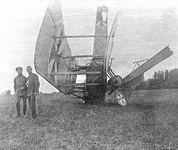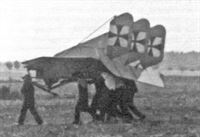
Описание
Страна: Германия
Год: 1915
G.Haddow, P.Grosz The German Giants (Putnam)
Union G.I
In 1912 the Union-Flugzeugwerke G.m.b.H. was founded at Teltow near Berlin by an aircraft designer named Karl Bomhard, who had previously participated in the design of the Lohner arrow-biplanes (Pfeilflieger) in Austria. He was joined by Dr. Josef Sablatnig (in 1913) and Georg Konig. These two engineers constructed the Union arrow-biplanes based on Bomhard's designs, which were then quite the vogue. One of these aircraft won three world-altitude records with passengers for Germany in 1913.
At the end of the year 1914 Union began construction of a large four-engined bomber which fell into the same category as the SSW-Forssman R-plane and, like this machine, the engines of the Union G.I were not serviceable in flight, but its size merits inclusion in this book. On 13 April 1915 the framework of the Union G.I was inspected by Government engineers, who called its construction good, but its estimated speed of 95 km.h. (59-4 m.p.h.) was criticized as being too slow, and its estimated bomb load was considered to be insufficient. It was powered by four inverted 110 h.p. Mercedes engines mounted a tandem pairs in fully-enclosed nacelles on the lower wing. The airframe was typical of the period, constructed of wood, wire-braced and fabric-covered; however, there is some indication that the fuselage was sheathed in plywood veneer. The tail assembly consisted of a single tailplane and elevator surmounted by three parallel rudders, the middle one hinged to a triangular fin. The designers of the Union G.I were Baurat Rittberger and Karl Schopper.
The Union G.I first flew in May 1915, subsequently it suffered damage, but it ultimate fate is unknown. Because Daimler had intentions of entering into the aircraft construction business, it placed an order for a second G.I and transferred a number of workers to the Union shops to learn the aircraft trade.
The airframe of the second Union G.I was strengthened, but overall dimension remained the same. This machine, bearing the name "Marga-Emmy" painted on its nose, was stationed at the airfield in Schneidemuhl. During a test flight on 1 September 1915 with pilot Thassler at the controls, severe engine vibrations forced him to make an emergency landing at Schloss Eberspark near Schneidemuhl. The vibrations were so great that the G.I airframe broke apart shortly before touch-down. There were no injuries to the crew. Structural weakness was the cause of the first G.I breaking in two during take-off or landing.
The aircraft were not rebuilt, but an improved version was continued as the Daimler R.I and Daimler R.II. On 1 August 1916 the Union-Flugzeugwerke went into liquidation and its assets were taken over by the Norddeutsche Flugzeugwerke, which spent the remainder of the war years repairing aircraft.
SPECIFICATIONS
Type: Union G.I.
Manufacturer: Union-Flugzeugwerke G.m.b.H., Teltow, Berlin
Engines: Four 110 h.p. Mercedes Fh 1256 engines (inverted)
Dimensions:
Span, 21•0 m. (68 ft. 10 1/2 in.)
Length, 18•2 m. (59 ft. 8 1/2 in.)
Height, 3•74 m. (12 ft. 3 in.)
Areas: Wings, 72-40 sq. m. (779 sq. ft.)
Weights:
Empty, 1960 kg. (4321 lb.)
Loaded, 2765 kg. (6096 lb.)
Wing Loading: 38•20 kg./sq. m. (7'8 lb./sq. ft.)
Performance:
Maximum speed, 128 km.h. (79'5 m.p.h.)
Cruising speed, 115 km.h. (71'5 m.p.h.)
Climb,
1000 m. (3281 ft.) in 14•5 mins.
1500 m. (4921 ft.) in 24•2 mins.
Ceiling, 3500 m. (11,483 ft.)
Описание:
- G.Haddow, P.Grosz The German Giants (Putnam)
- J.Herris German Aircraft of Minor Manufacturers in WW1. Vol I (A Centennial Perspective on Great War Airplanes 49)
- M.Dusing German Aviation Industry in WWI. Volume 2 (A Centennial Perspective on Great War Airplanes 85)
Фотографии
-
J.Herris - German Aircraft of Minor Manufacturers in WW1. Volume I /Centennial Perspective/ (49)
The Union G.I had four 110 hp Mercedes engines mounted in tandem pairs.
-
J.Herris - German Aircraft of Minor Manufacturers in WW1. Volume I /Centennial Perspective/ (49)
The Union G.I being readied for flight while at Feld-Flieger Abteilung 26.
-
J.Herris - German Aircraft of Minor Manufacturers in WW1. Volume I /Centennial Perspective/ (49)
The Union G.I experimental bomber (1915)
-
J.Herris - German Aircraft of Minor Manufacturers in WW1. Volume I /Centennial Perspective/ (49)
Military personnel inspect the Union G.I.
-
J.Herris - German Aircraft of Minor Manufacturers in WW1. Volume I /Centennial Perspective/ (49)
More view of the Union G.l. (Peter M. Grosz collection, STDB)
-
J.Herris - German Aircraft of Minor Manufacturers in WW1. Volume I /Centennial Perspective/ (49)
More view of the Union G.l. (Peter M. Grosz collection, STDB)
-
J.Herris - German Aircraft of Minor Manufacturers in WW1. Volume I /Centennial Perspective/ (49)
First Union G.I. In contrast to the later Daimler G.I version, the engines were mounted directly on the lower wing.
-
J.Herris - German Aircraft of Minor Manufacturers in WW1. Volume I /Centennial Perspective/ (49)
More view of the Union G.I. (Peter M. Grosz collection, STDB)
-
J.Herris - German Aircraft of Minor Manufacturers in WW1. Volume I /Centennial Perspective/ (49)
The management of Union-Flugzeugwerke celebrates the completion of the G aircraft together with the plant personnel.
Photo of the Union G.I. Daimler supplied the four 110 hp Mercedes engines mounted in tandem pairs. These engines were unusual in being inverted, that is, the cylinders were below the crankcase.The Union G.I was also known as the R.l (the "R" standing for Riesenflugzeug - Giant airplane) due to its four engines, but it was not a proper R-type because the engines were not accessible in flight as specified by the R-type requirements, so it was re-designated a G-type. -
J.Herris - German Aircraft of Minor Manufacturers in WW1. Volume I /Centennial Perspective/ (49)
The Union G.I was named Marga-Emmy after it was assigned to Feld-Flieger Abteilung 26.
-
J.Herris - German Aircraft of Minor Manufacturers in WW1. Volume I /Centennial Perspective/ (49)
The tail before application of national insignia. (Peter M. Grosz collection, STDB)
-
J.Herris - German Aircraft of Minor Manufacturers in WW1. Volume I /Centennial Perspective/ (49)
The Union G.I taking off.
-
J.Herris - German Aircraft of Minor Manufacturers in WW1. Volume I /Centennial Perspective/ (49)
The Union G.I experiencing a take-off accident.
-
J.Herris - German Aircraft of Minor Manufacturers in WW1. Volume I /Centennial Perspective/ (49)
The end of the Union G.I and the Union company after its landing accident on September 1, 1915 at Schloss Eberspark (Schneidemuhl).The pilot, Thassler, and observer Lt. Neuensitz were unhurt and pose with the aircraft. The tail has broken off the fuselage.
-
J.Herris - German Aircraft of Minor Manufacturers in WW1. Volume I /Centennial Perspective/ (49)
The tail of the Union G.I is carried back to the hangars after its landing accident on September 1, 1915 at Schloss Eberspark (Schneidemuhl). The pilot, Thassler, made a hard landing and broke the tail off the aircraft. The G.I was not repaired after this accident.
















